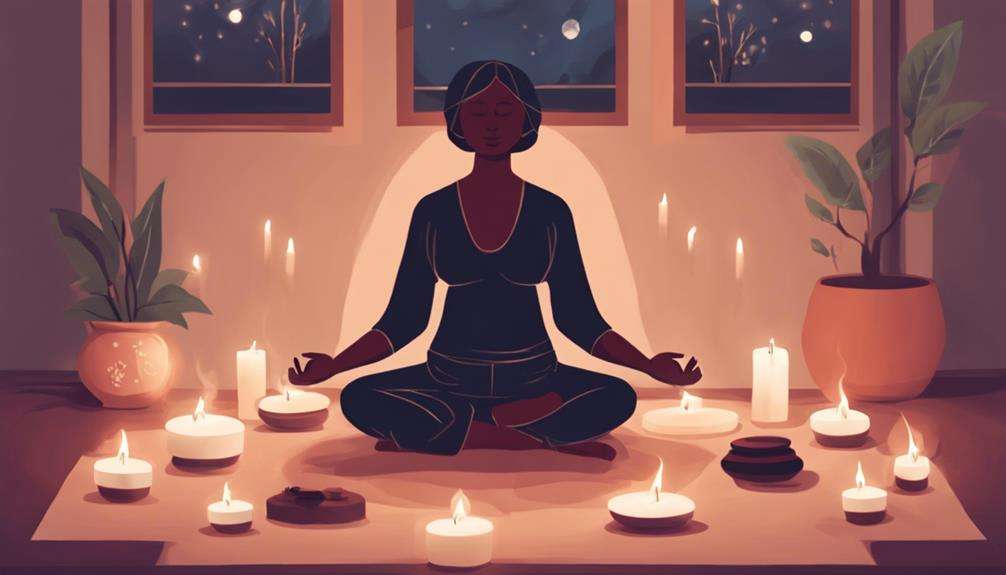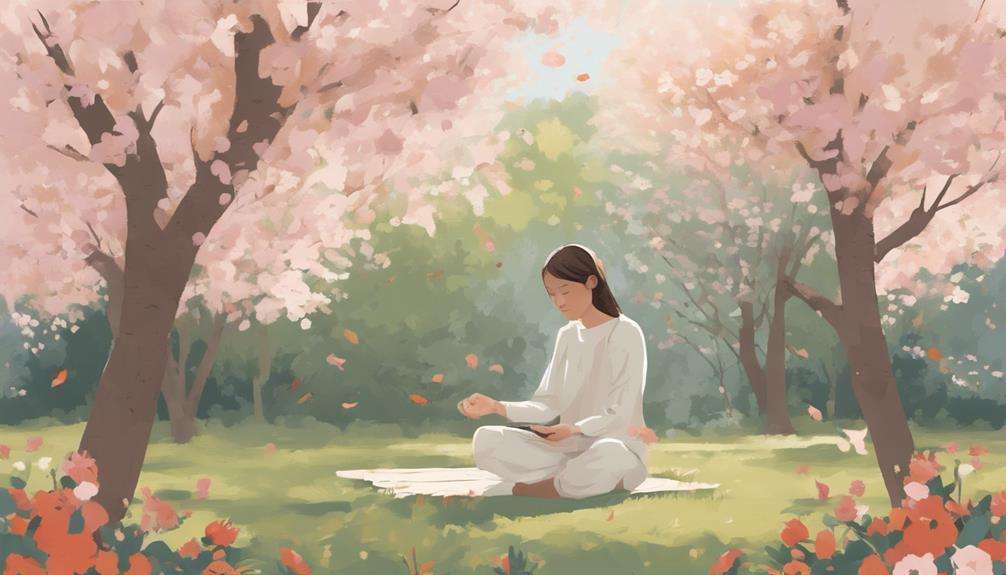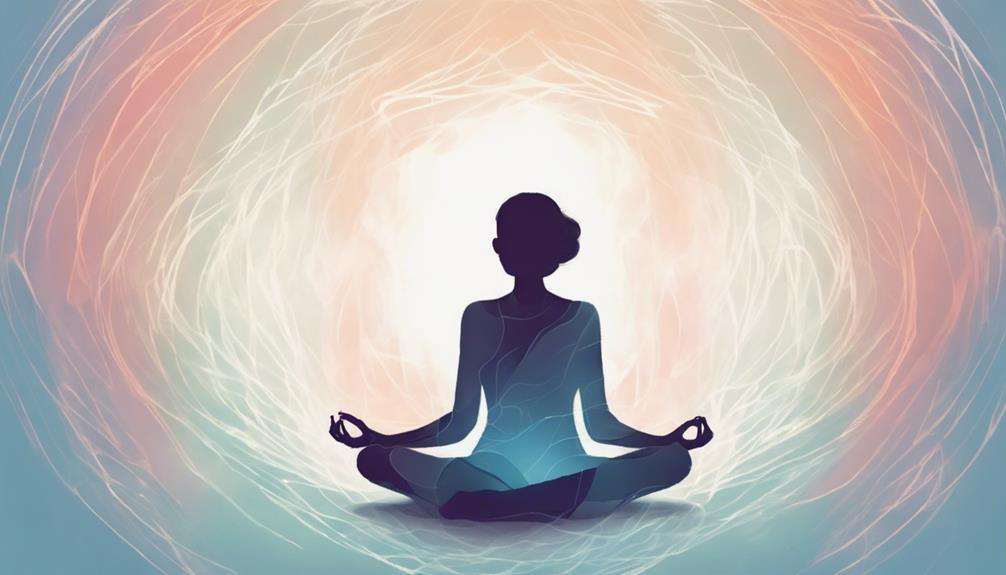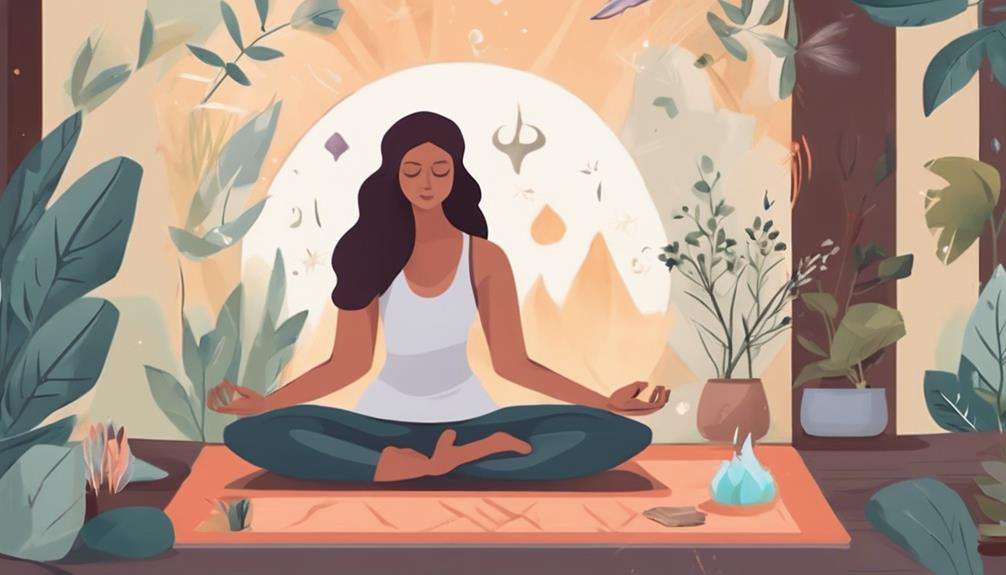Are you looking for effective ways to alleviate anxiety and promote relaxation in your daily life?
Discover the top 10 relaxation techniques that have been proven to reduce stress levels and enhance mental well-being.
Explore a range of practices, from deep breathing exercises to mindfulness meditation, that can help you achieve a sense of calm and focus in the midst of life's challenges.
Learn how incorporating these techniques into your routine can lead to improved emotional resilience and a greater sense of inner peace.
Key Takeaways
- Deep breathing and muscle relaxation techniques effectively reduce anxiety.
- Meditation practices like body scan and visualization promote relaxation.
- Mindfulness meditation enhances emotional well-being and cognitive function.
- Daily relaxation practices, including mindfulness and rhythmic movements, improve overall well-being.
Deep Breathing Techniques
To begin your journey towards greater calmness and reduced anxiety, let's explore the power of deep breathing techniques. Deep breathing is a simple yet effective way to activate your body's relaxation response, helping to reduce stress levels significantly.
By focusing on taking full, deep breaths, you can engage in this practice almost anywhere, allowing yourself a moment of tranquility even in the midst of a busy day. Combining deep breathing with calming music or aromatherapy can enhance the relaxation experience, making it even more soothing and rejuvenating.
This technique doesn't require much time and can be done in just a few minutes, providing immediate relief from tension and anxiety. Utilizing apps or audio guides can assist you in mastering deep breathing, but the process itself is straightforward and immensely beneficial for managing stress.
Learning to control your breath through deep breathing lays a solid foundation for other relaxation practices, making it an essential skill in your journey towards a more peaceful and balanced state of mind.
Progressive Muscle Relaxation
Progressive Muscle Relaxation guides you through systematically tensing and relaxing different muscle groups to reduce stress and promote deep relaxation. By focusing on each muscle group from your feet to your head, this technique helps you become more aware of physical tension you may be holding onto.
When combined with deep breathing exercises, Progressive Muscle Relaxation offers a powerful way to release muscle tension and alleviate anxiety. Regular practice of this method can enhance your body awareness, reduce anxiety symptoms, and improve overall well-being.
This evidence-based relaxation technique is simple yet effective, making it a valuable tool in managing stress and promoting relaxation. Remember, the key is to take the time for yourself, focus on each muscle group, and let go of the tension you're holding onto. Embrace Progressive Muscle Relaxation as a way to unwind, destress, and find calm amidst life's challenges.
Body Scan Meditation
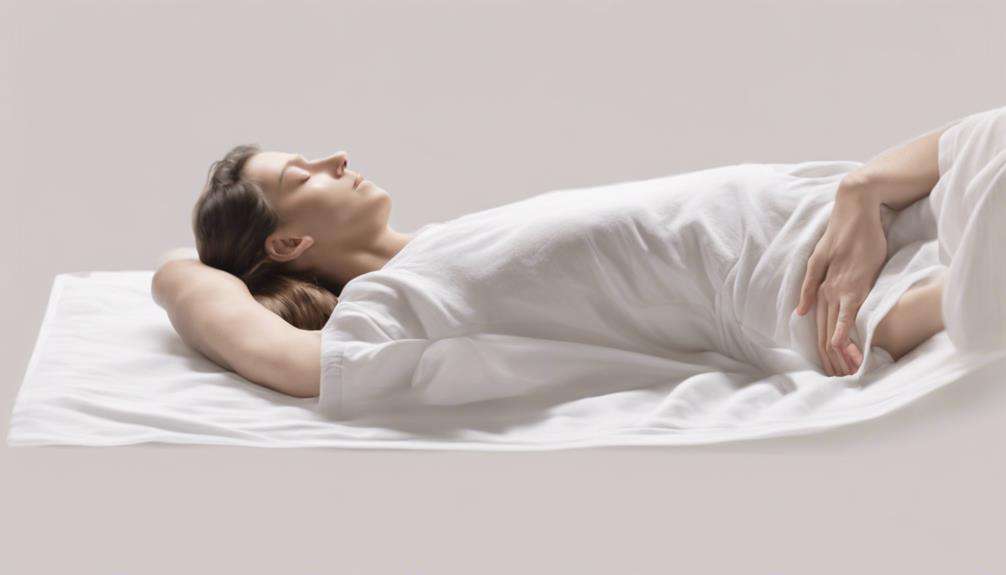
Are you looking to cultivate mindful awareness of your bodily sensations?
Body scan meditation could be the perfect technique for you.
Mindful Awareness of Sensations
Embark on a journey of self-discovery and tranquility by delving into the practice of Body Scan Meditation. This profound technique fosters mindfulness through attentive awareness of bodily sensations.
As you focus on different body parts without judgment, you can recognize and release tension and stress, promoting relaxation and mindfulness. Starting from your feet and moving upwards, Body Scan Meditation helps calm both the mind and body.
By paying attention to physical sensations, this practice can reduce anxiety while increasing self-awareness. Embrace the opportunity to connect with your body, allowing yourself to relax and unwind.
Let the practice of Body Scan Meditation guide you towards a state of peace and inner balance.
Progressive Relaxation Technique
Begin your relaxation journey with the Body Scan Meditation technique, a method that systematically focuses on different body parts to release tension and promote relaxation.
Body scan meditation involves starting from the feet and moving upwards, enhancing mindfulness and body awareness. By recognizing and acknowledging bodily sensations without judgment, you can effectively reduce stress and anxiety. This practice aids in promoting overall well-being by improving the mind-body connection and enhancing relaxation responses.
Regular practice of body scan meditation can lead to a calmer state of mind and a more relaxed body. Embrace this technique as a valuable tool for stress reduction and cultivating a sense of peace within yourself. Take time to scan your body, breathe deeply, and let go of tension.
Focus on Each Body Part
Shift your focus to each body part as you engage in the calming practice of Body Scan Meditation, allowing yourself to release tension and embrace relaxation. Body scan meditation is a powerful technique that promotes mindfulness by systematically moving your attention from one body part to another. By tuning into each area, you can identify and alleviate tension, discomfort, or stress held within your body.
This practice enhances your awareness of both physical sensations and emotional states, helping you unwind and let go of anxiety. Whether practiced alone or with guided instructions, body scan meditation is effective in reducing stress levels, fostering relaxation, and improving overall well-being. Embrace this method to cultivate a sense of calm and peace within yourself.
Visualization Practices

When practicing visualization techniques, engage all your senses to create a calming and peaceful scene in your mind. Visualizing a serene setting can be a powerful relaxation exercise to reduce anxiety and promote mental clarity.
Here are some tips to enhance your visualization practices:
- Immerse Yourself: Fully immerse yourself in the imagined scenario by visualizing detailed sights, sounds, smells, textures, and even tastes.
- Use Positive Imagery: Focus on positive and soothing images to counteract negative thoughts and emotions.
- Practice Regularly: Dedicate time each day to practice visualization to reap its long-term benefits for stress relief.
- Guided Imagery Sessions: Consider participating in guided imagery sessions led by professionals to deepen your practice.
- Reflect on Feelings: After each visualization session, take a moment to reflect on how it made you feel and any insights gained.
Self-Massage Techniques
As you explore ways to alleviate anxiety and promote relaxation, consider incorporating self-massage techniques into your routine for a calming and rejuvenating experience. Just like professional massages, self-massage can help reduce stress, relieve pain, and ease muscle tension. You don't need to be an expert to enjoy the benefits of self-massage. You can easily perform self-massage at home or work, using aromatic oils or scented lotions to enhance the experience.
One great way to elevate your self-massage practice is to trade massages with a loved one. This not only promotes relaxation but also strengthens your bond through shared experiences. If you have an adjustable bed with built-in massage features, take advantage of this luxury for added comfort and stress relief.
Mindfulness Meditation
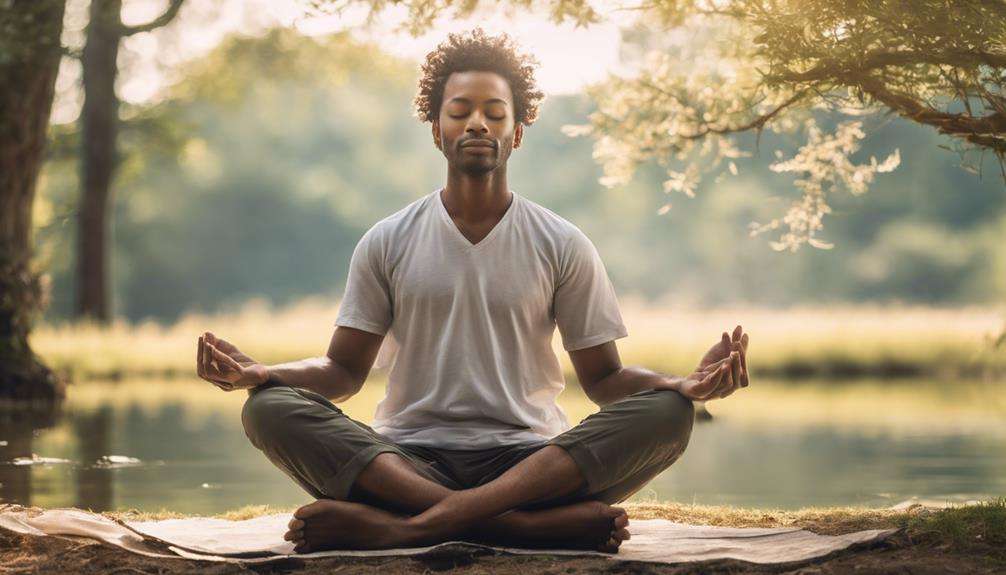
When it comes to reducing anxiety, mindfulness meditation can be a powerful tool for you. By focusing on the present moment and practicing daily, you can experience the benefits of improved self-awareness and emotional regulation.
Stay present and focused during meditation to help alleviate anxiety and enhance your overall well-being.
Benefits of Meditation
Mindfulness meditation offers a range of benefits, including reducing symptoms of anxiety, depression, and chronic pain, as supported by research studies. Engaging in this practice can significantly enhance your emotional well-being, decrease stress levels, and promote relaxation through focused attention. Additionally, mindfulness meditation has been shown to increase gray matter in brain regions associated with memory, learning, and emotion regulation. Regularly incorporating this practice into your routine can improve your attention span, cognitive function, and overall mental clarity. Studies also indicate that mindfulness meditation leads to reductions in perceived stress and improvements in emotional regulation.
- Enhances emotional well-being
- Decreases stress levels
- Promotes relaxation through focused attention
- Increases gray matter in key brain regions
- Improves attention span and cognitive function
Practice Techniques Daily
To experience the full benefits of mindfulness meditation, aim to incorporate daily practice techniques into your routine for at least 20 minutes. Regular practice of mindfulness meditation is key to reducing anxiety and building a sense of calm that can be accessed during stressful situations.
By dedicating time each day to mindfulness meditation, you can enhance your mental clarity and overall well-being. This practice helps in developing an increased awareness of the mind-body connection, allowing you to better manage stress and anxiety.
Make it a habit to prioritize your daily mindfulness meditation sessions – it's a powerful tool to promote relaxation and cultivate a sense of peace amidst life's challenges.
Stay Present and Focused
Make a conscious effort to anchor yourself in the present moment through mindfulness meditation, allowing yourself to stay focused and aware of your thoughts, emotions, and sensations. Mindfulness meditation is a powerful tool to reduce anxiety and promote relaxation. By practicing this technique, you can enhance your attention span, improve emotional regulation, and boost your overall well-being. Research has shown that regular sessions of mindfulness meditation can significantly decrease symptoms of anxiety and stress.
Embrace the practice of staying present and focused to experience long-term benefits in managing anxiety. Remember, mindfulness meditation is a valuable skill that can help you cultivate a sense of calm and peace in your daily life.
- Focus on your breath to center yourself in the present moment.
- Notice and acknowledge your thoughts without judgment.
- Engage your senses to ground yourself in the here and now.
- Practice gratitude to cultivate a positive mindset.
- Set aside dedicated time each day for mindfulness meditation.
Rhythmic Movement Exercises
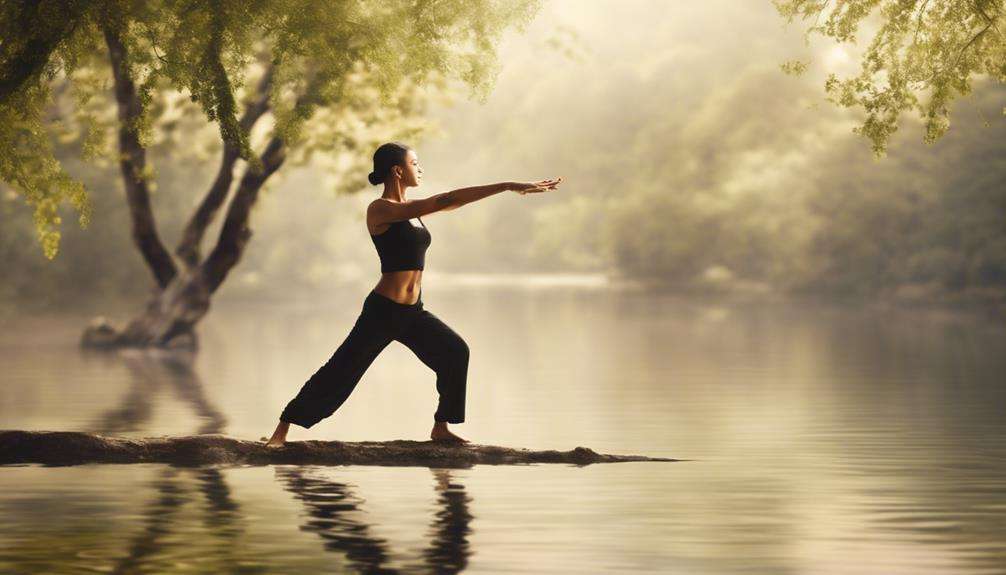
Engaging in rhythmic movement exercises like walking, running, or swimming can effectively induce relaxation by involving both your body and mind. These activities encourage mindfulness as you focus on the sensations in your body and synchronize your movements with your breathing. By being fully present in the moment during rhythmic exercises, you can actively reduce anxiety and stress.
Rhythmic movement exercises offer a straightforward yet powerful way to unwind after a taxing day. Coordinating your breath with your movements amplifies the relaxation response within your body, aiding in calming your mind and releasing tension. Whether you choose a brisk walk in nature, a steady jog, or a refreshing swim, the rhythmic nature of these exercises can help you find a sense of peace and tranquility.
Embrace the opportunity to connect with your body and breath, allowing the rhythm to guide you towards a more relaxed state of being.
Yoga for Anxiety Relief
If you're looking for effective ways to manage anxiety, exploring yoga poses for anxiety relief and breathing techniques for calmness can be incredibly beneficial.
By incorporating these practices into your routine, you can experience the calming effects that yoga offers, helping to ease your mind and body from anxiety symptoms.
Yoga's focus on mindfulness and physical movement provides a holistic approach to reducing anxiety over time.
Yoga Poses for Anxiety
Explore how incorporating specific yoga poses into your daily routine can effectively alleviate anxiety and promote a sense of calm and relaxation. Practicing yoga for anxiety relief involves controlled breathing, gentle movements, and mindfulness to reduce stress.
Here are five yoga poses for anxiety that can help you find peace amidst the chaos:
- Child's Pose: Calms the mind and gently stretches the back.
- Legs Up the Wall: Promotes relaxation and helps in reducing tension.
- Corpse Pose: Encourages deep relaxation and releases stress from the body.
- Downward Facing Dog: Relieves anxiety by stretching the entire body.
- Bridge Pose: Opens up the chest and heart, easing anxious feelings.
Incorporating these poses into your routine can enhance your emotional well-being and bring balance to your life.
Breathing Techniques for Calmness
To cultivate a sense of calmness and alleviate anxiety, practicing specific breathing techniques in yoga can be highly effective. By incorporating controlled breathing into your yoga practice, you activate the body's relaxation response, leading to a decrease in heart rate and blood pressure.
Focused breathing exercises in yoga not only help in anxiety relief but also enhance emotional well-being and mental clarity. When combined with yoga poses, mindful breathing promotes relaxation, releasing tension from both the mind and body.
Research supports yoga as a beneficial tool for stress management and anxiety-related disorders, making it a valuable addition to your relaxation techniques. Embrace the power of breath and yoga to foster calmness and combat anxiety effectively.
Tai Chi for Calming the Mind

Tai Chi, an ancient Chinese martial art combining gentle movements, deep breathing, and meditation, offers a powerful way to calm the mind and promote relaxation. Practicing Tai Chi can be a soothing experience that not only relaxes the body but also eases the mind, making it an excellent tool for managing anxiety and stress.
Here are some benefits of incorporating Tai Chi into your routine:
- Moving Meditation: Tai Chi is often referred to as 'moving meditation,' focusing on balance and the flow of energy.
- Stress Reduction: Regular practice of Tai Chi has been shown to reduce stress, anxiety, and depression, promoting overall mental well-being.
- Mind-Body Harmony: Tai Chi enhances flexibility, strength, and coordination, fostering a sense of harmony between the mind and body.
- Physical Health: Studies have demonstrated that Tai Chi can lower cortisol levels, decrease heart rate, and improve sleep quality.
- Emotional Balance: By practicing Tai Chi, you can improve your emotional balance and cultivate a sense of inner peace.
Combining Yoga and Meditation
Discover the powerful synergy of combining yoga and meditation to cultivate a profound sense of calmness and inner peace, reducing symptoms of anxiety. Yoga involves physical postures that enhance flexibility, balance, and mental clarity, while meditation focuses on mindfulness and relaxation techniques. By integrating these practices, you can effectively manage stress and anxiety levels.
Engaging in yoga poses not only benefits your physical health but also calms the mind. The rhythmic movements paired with deep breathing promote a state of relaxation, easing feelings of tension and worry. On the other hand, meditation encourages you to be present in the moment, fostering a sense of mindfulness that allows you to let go of anxious thoughts.
Research supports the notion that the combination of yoga and meditation positively impacts mental health. Regular practice can help you develop coping mechanisms for anxiety and improve your overall well-being. Embrace this holistic approach to find peace and tranquility amidst life's challenges.
Frequently Asked Questions
What Relaxation Techniques Are Best for Anxiety?
For anxiety relief, try deep breathing to calm your mind, progressive muscle relaxation to release tension, and visualization meditation to create soothing mental images. Grounding techniques, mindfulness exercises, and guided imagery can also help.
Why Can't I Relax and Enjoy Life?
You struggle to find balance and enjoy life due to overthinking and stress. Embrace mindful living, prioritize self-care practices, and overcome obstacles with a positive mindset. Cultivating inner peace through relaxation techniques can help you thrive.
What Are Calming Skills for Anxiety?
When feeling anxious, try deep breathing to calm your mind. Practice mindfulness meditation, progressive muscle relaxation, visualization exercises, grounding techniques, and yoga poses to reduce stress. These skills promote relaxation and enhance well-being effectively.
What Is the Best Way to Deal With Stress and Anxiety?
To deal with stress and anxiety, try deep breathing exercises, mindfulness meditation, progressive muscle relaxation, yoga poses, nature walks, and stress balls. These techniques can help calm your mind, relax your body, and reduce anxiety levels effectively.
Conclusion
So there you have it – the 10 best relaxation techniques to reduce anxiety. Remember, taking care of your mental well-being is crucial in today's fast-paced world.
Who knew that finding peace and calm could be as simple as breathing deeply or practicing yoga? So go ahead, give these techniques a try and watch your anxiety melt away.
It's ironic how something so simple can have such a powerful impact on your mind and body. You deserve to feel relaxed and at peace – give yourself that gift.

